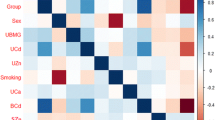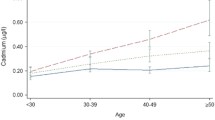Abstract
Objectives: To examine whether the current level of environmental exposure to cadmium (Cd) is associated with kidney dysfunction among general populations in Japan. Methods: A nationwide survey was conducted in Japan from 1991 to 1997 at 30 survey sites (with no known environmental heavy metal pollution), by the collection of 24-h food-duplicate samples, peripheral blood specimens and morning spot urine samples. In practice, 607 non-smoking adult women provided these samples. After being wet-ashed, the samples were analyzed for Cd in food duplicates (Cd-F), in blood (Cd-B) and urine (Cd-U) by inductively-coupled plasma mass spectrometry (ICP-MS). Urine samples were also analyzed for α1-microglobulin (α1-MG), β2-microglobulin (β2-MG) and retinol-binding protein (RBP), creatinine (cr) and specific gravity. Possible tubular dysfunction in association with Cd exposure was examined by simple, multiple and logistic regression analyses, and comparison among three different Cd-dose groups. To minimize the confounding effects of aging, 367 women from 41 to 60 years old were selected and subjected to the same statistical analyses. Results: The analysis of a whole population of 607 women showed that α1-MG and possibly β2-MG increased as a function of Cd-F, Cd-B and Cd-U. When the analysis was repeated with the selected population of 367 women aged 41–60, the Cd dose-dependent changes in α1-MG and β2-MG became less evident. The distribution of the selected population with α1-MG above two low cut-off values of >4.9 and >8.4 mg/g cr or with β2-MG above the lowest cut-off value of >400 μg/g cr, was biased toward the group with higher Cd-Ucr, but such bias was not significant for both α1-MG and β2-MG when higher cut-off values were employed. No bias was detected with RBP. Logistic regression analysis with α1-MG, β2-MG and RBP (with cut-off values given above) in combination with age, Cd-F, Cd-B and Cd-Ucr gave essentially the same results. Conclusions: The evidence for kidney dysfunction was of borderline significance in the present study population for which geometric mean Cd-F, Cd-B and Cd-U were 24.7 μg/day, 1.76 μg/l, and 3.94 μg/g cr, respectively. The findings might suggest at the same time that the safety margin is small for the Japanese general population regarding environmental Cd exposure.
Similar content being viewed by others
Author information
Authors and Affiliations
Additional information
Received: 26 February 1999 / Accepted: 24 July 1999
Rights and permissions
About this article
Cite this article
Ikeda, M., Zhang, ZW., Moon, CS. et al. Possible effects of environmental cadmium exposure on kidney function in the Japanese general population. Int Arch Occup Environ Health 73, 15–25 (2000). https://doi.org/10.1007/PL00007933
Issue Date:
DOI: https://doi.org/10.1007/PL00007933




